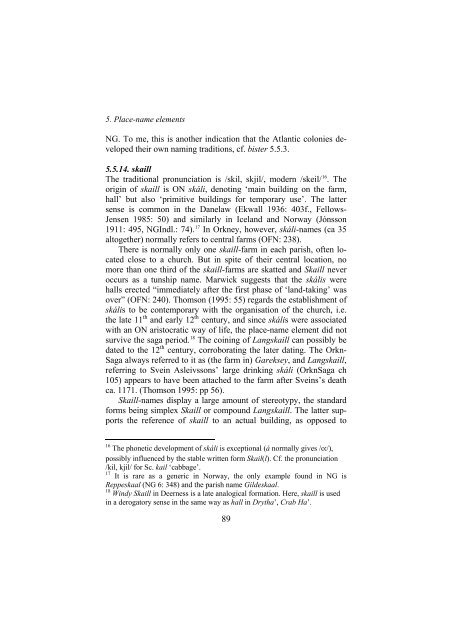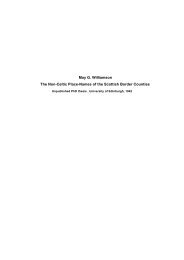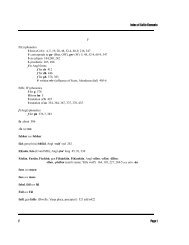- Page 1 and 2:
From Starafjall to Starling Hill An
- Page 3 and 4:
Contents Foreword………………
- Page 5 and 6:
8.3. Morphosyntax ……………
- Page 7 and 8:
1. Introduction Chapter 1. Introduc
- Page 9 and 10:
1. Introduction tive names form the
- Page 11 and 12:
2. Historical background letterform
- Page 13 and 14:
2. Historical background wise lost.
- Page 15 and 16:
2. Historical background autonomous
- Page 17 and 18:
2. Historical background have been
- Page 19 and 20:
2. Historical background Scottish d
- Page 21 and 22:
2. Historical background On the oth
- Page 23 and 24:
2. Historical background power to c
- Page 25 and 26:
2. Historical background came mayor
- Page 27 and 28:
2. Historical background Mainland p
- Page 29 and 30:
2. Historical background Norn canno
- Page 31 and 32:
2. Historical background Norse, Nor
- Page 33 and 34:
Chapter 3. Former research 3.1. Pla
- Page 35 and 36:
3. Former research Nicolaisen stres
- Page 37 and 38: 3. Former research Norn was spoken
- Page 39 and 40: 3. Former research say at this time
- Page 41 and 42: 3. Former research date for Banks i
- Page 43 and 44: 3. Former research such as quoy (<
- Page 45 and 46: 3. Former research This is less lin
- Page 47 and 48: 3. Former research Secondary hybrid
- Page 49 and 50: 3. Former research logical relevanc
- Page 51 and 52: 3. Former research this way, names
- Page 53 and 54: 4. The languages 4.1. A brief histo
- Page 55 and 56: 4. The languages 4.2. Structural ch
- Page 57 and 58: 4. The languages 4.2.1.3. Vowel inv
- Page 59 and 60: 4. The languages positions at the p
- Page 61 and 62: 4. The languages ral and the geniti
- Page 63 and 64: 4. The languages In Orkney, the lan
- Page 65 and 66: 4. The languages whereas the Scandi
- Page 67 and 68: 4. The languages Pettersen regards
- Page 69 and 70: 4. The languages Prayer and goand d
- Page 71 and 72: 4. The languages ö > ç, e, E, √
- Page 73 and 74: 4. The languages 4.4.3. Lexical fea
- Page 75 and 76: Chapter 5. Place name elements 5.1
- Page 77 and 78: 5. Place-name elements period as we
- Page 79 and 80: 5. Place-name elements 5.5. Common
- Page 81 and 82: 5. Place-name elements with clear l
- Page 83 and 84: 5. Place-name elements X in other p
- Page 85 and 86: 5. Place-name elements names; more
- Page 87: 5. Place-name elements 5.5.12. mo(r
- Page 91 and 92: 5. Place-name elements The appellat
- Page 93 and 94: Chapter 6. The place-name material
- Page 95 and 96: 6. The name material the gen. ákr.
- Page 97 and 98: 6. The name material formation may
- Page 99 and 100: 6. The name material They may conta
- Page 101 and 102: 6. The name material Brendo ON Firt
- Page 103 and 104: 6. The name material is a LGerm loa
- Page 105 and 106: 6. The name material Cot quoyland 1
- Page 107 and 108: 6. The name material Cruan 1868 OA
- Page 109 and 110: 6. The name material 4 ½-pennyland
- Page 111 and 112: 6. The name material A former cot h
- Page 113 and 114: 6. The name material Farm in Outer
- Page 115 and 116: 6. The name material ness below). U
- Page 117 and 118: 6. The name material Graemshall 188
- Page 119 and 120: 6. The name material the generic kv
- Page 121 and 122: 6. The name material Helliekloiff 1
- Page 123 and 124: 6. The name material from the first
- Page 125 and 126: 6. The name material House above Re
- Page 127 and 128: 6. The name material A farm and a v
- Page 129 and 130: 6. The name material Lyde /laid/ ON
- Page 131 and 132: 6. The name material Millbridge 174
- Page 133 and 134: 6. The name material Netherbigging
- Page 135 and 136: 6. The name material Nistoo /»nIst
- Page 137 and 138: 6. The name material Farm in Costa,
- Page 139 and 140:
6. The name material 5.5.13. 21 Ren
- Page 141 and 142:
6. The name material Redland /»red
- Page 143 and 144:
6. The name material Formerly a 6-p
- Page 145 and 146:
6. The name material burn name Renn
- Page 147 and 148:
6. The name material Inkster and Mo
- Page 149 and 150:
6. The name material Smogarth /smog
- Page 151 and 152:
6. The name material generic of Ste
- Page 153 and 154:
6. The name material Trundigar, Tro
- Page 155 and 156:
6. The name material Crofts in Cost
- Page 157 and 158:
6. The name material Wasdale 1502 R
- Page 159 and 160:
6. The name material 6.2. Non-habit
- Page 161 and 162:
6. The name material means ‘grazi
- Page 163 and 164:
6. The name material Banks /baNks/
- Page 165 and 166:
6. The name material ‘well, sprin
- Page 167 and 168:
6. The name material Bloodo Bloodo
- Page 169 and 170:
6. The name material be taken into
- Page 171 and 172:
6. The name material pound name con
- Page 173 and 174:
6. The name material names as their
- Page 175 and 176:
6. The name material Recorded as a
- Page 177 and 178:
6. The name material same construct
- Page 179 and 180:
6. The name material packsaddle’
- Page 181 and 182:
6. The name material sheep-right
- Page 183 and 184:
6. The name material Cuffie Hill Sc
- Page 185 and 186:
6. The name material Dale of Cottas
- Page 187 and 188:
6. The name material A field in Hac
- Page 189 and 190:
6. The name material pronunciation
- Page 191 and 192:
6. The name material The somewhat r
- Page 193 and 194:
6. The name material Fala Fala 1897
- Page 195 and 196:
6. The name material Fuffy Sc Tidal
- Page 197 and 198:
6. The name material Geo /gjo, djo/
- Page 199 and 200:
6. The name material low. The eleme
- Page 201 and 202:
6. The name material Greeny Grip Fi
- Page 203 and 204:
6. The name material Field belongin
- Page 205 and 206:
6. The name material Harpy Taing Sc
- Page 207 and 208:
6. The name material ‘valley’ a
- Page 209 and 210:
6. The name material A cleft and an
- Page 211 and 212:
6. The name material A field belong
- Page 213 and 214:
6. The name material Kirk Sheed Sc
- Page 215 and 216:
6. The name material pound name, pr
- Page 217 and 218:
6. The name material Firth. HY 35 1
- Page 219 and 220:
6. The name material Norway and She
- Page 221 and 222:
6. The name material former ON sphe
- Page 223 and 224:
6. The name material The name prese
- Page 225 and 226:
6. The name material A field north
- Page 227 and 228:
6. The name material ‘manure encl
- Page 229 and 230:
6. The name material A strip of mos
- Page 231 and 232:
6. The name material Pantland Craig
- Page 233 and 234:
6. The name material A number of fa
- Page 235 and 236:
6. The name material There was an a
- Page 237 and 238:
6. The name material Rendall. HY 41
- Page 239 and 240:
6. The name material Rowamo Firth 1
- Page 241 and 242:
6. The name material A field (in Co
- Page 243 and 244:
6. The name material A stretch of c
- Page 245 and 246:
6. The name material 7) Slap of Quo
- Page 247 and 248:
6. The name material stakka ‘stac
- Page 249 and 250:
6. The name material Stooslass A lo
- Page 251 and 252:
6. The name material Toomal, Tumal(
- Page 253 and 254:
6. The name material Troffers, The
- Page 255 and 256:
6. The name material Varmadale /»v
- Page 257 and 258:
6. The name material fish or birds
- Page 259 and 260:
6. The name material wart ‘beacon
- Page 261 and 262:
6. The name material cracks and bul
- Page 263 and 264:
6. The name material Whistlebare Sc
- Page 265 and 266:
Chapter 7. Name formation Orkney pl
- Page 267 and 268:
7. Name formation ON árkvísl ‘f
- Page 269 and 270:
7. Name formation 7.1.2. Scots form
- Page 271 and 272:
7. Name formation 7.1.2.1. Criteria
- Page 273 and 274:
7. Name formation and tún/town. Th
- Page 275 and 276:
7. Name formation names as examples
- Page 277 and 278:
7. Name formation ferent, as they p
- Page 279 and 280:
7. Name formation There are few exa
- Page 281 and 282:
7. Name formation This name formati
- Page 283 and 284:
7. Name formation throughout time,
- Page 285 and 286:
7. Name formation also select an it
- Page 287 and 288:
7. Name formation but intensive col
- Page 289 and 290:
7. Name formation Time is certainly
- Page 291 and 292:
Chapter 8. Structural features obse
- Page 293 and 294:
8. Structural features observed in
- Page 295 and 296:
8. Structural features observed in
- Page 297 and 298:
8. Structural features observed in
- Page 299 and 300:
8. Structural features observed in
- Page 301 and 302:
8. Structural features observed in
- Page 303 and 304:
8. Structural features observed in
- Page 305 and 306:
8. Structural features observed in
- Page 307 and 308:
8. Structural features observed in
- Page 309 and 310:
8. Structural features observed in
- Page 311 and 312:
8. Structural features observed in
- Page 313 and 314:
8. Structural features observed in
- Page 315 and 316:
8. Structural features observed in
- Page 317 and 318:
8. Structural features observed in
- Page 319 and 320:
8. Structural features observed in
- Page 321 and 322:
8. Structural features observed in
- Page 323 and 324:
8. Structural features observed in
- Page 325 and 326:
8. Structural features observed in
- Page 327 and 328:
8. Structural features observed in
- Page 329 and 330:
8. Structural features observed in
- Page 331 and 332:
8. Structural features observed in
- Page 333 and 334:
8. Structural features observed in
- Page 335 and 336:
8. Structural features observed in
- Page 337 and 338:
8. Structural features observed in
- Page 339 and 340:
8. Structural features observed in
- Page 341 and 342:
8. Structural features observed in
- Page 343 and 344:
8. Structural features observed in
- Page 345 and 346:
Norsk resumé 9.1.1. Phonetic adapt
- Page 347 and 348:
Norsk resumé > ‘school hill’ a
- Page 349 and 350:
Norsk resumé adaptation to be acce
- Page 351 and 352:
Norsk resumé tion and loss of l in
- Page 353 and 354:
Norsk resumé A Rendall house-name
- Page 355 and 356:
Norsk resumé languages like Scandi
- Page 357 and 358:
Norsk resumé 9.3.1. Morphological
- Page 359 and 360:
Norsk resumé 9.3.2. Lexical and on
- Page 361 and 362:
Norsk resumé As for the three farm
- Page 363 and 364:
Norsk resumé The change from Breck
- Page 365 and 366:
Norsk resumé In the run-rig days,
- Page 367 and 368:
Norsk resumé The ON place-name ele
- Page 369 and 370:
Norsk resumé whether the burn was
- Page 371 and 372:
Norsk resumé other independently o
- Page 373 and 374:
Norsk resumé In addition, a famili
- Page 375 and 376:
Norsk resumé List of IPA phonetic
- Page 377 and 378:
Bibliography and abbreviations R (p
- Page 379 and 380:
Bibliography and abbreviations Dale
- Page 381 and 382:
Bibliography and abbreviations Kill
- Page 383 and 384:
Bibliography and abbreviations Rend
- Page 385 and 386:
Appendix 1. Onomastic and lexical a
- Page 387 and 388:
Appendices Appendix 3. Index of gen
- Page 389 and 390:
Appendices gar (Slap of), Longiger,
- Page 391 and 392:
Appendices Dicksquoy, Fealquoy, Gol
- Page 393 and 394:
Appendices topt ON ‘house-site’
- Page 395 and 396:
Index of place-names Boat Geo, 168
- Page 397 and 398:
Index of place-names Dwarmo, 188, 3
- Page 399 and 400:
Index of place-names Howea Breck, 2
- Page 401 and 402:
Index of place-names Nisnaquoy, 227
- Page 403 and 404:
Index of place-names Slap of Geeron
- Page 405:
Index of place-names Whistlebare, 2




